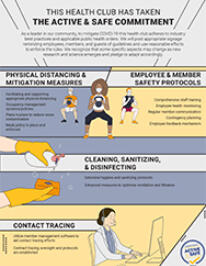On February 24, the Centers for Disease Control and Prevention (CDC) Morbidity and Mortality Weekly Report published two reports outlining case studies of COVID-19 outbreaks at fitness centers.
These outbreaks occurred in Honolulu, Hawaii in June, and Chicago, Illinois, in August. According to the reports, these incidents are the result of several, preventable factors.
Chicago, Illinois
In Chicago, 55 people were sickened when several people who had symptoms of—or had tested positive for—COVID-19 attended multiple fitness classes in one week. Specifically, two people who developed symptoms several days before the week of the outbreak attended five classes that week. The building likely had inadequate ventilation, and participants wore masks infrequently. According to the analysis, odds of infrequent mask use were over four times higher in those infected with COVID-19.
Honolulu, Hawaii
In Hawaii, the outbreak started with an infected instructor who taught a high-intensity cycling class—before his symptoms emerged—in a small, 400 square foot studio with doors closed. During the class, the instructor was talking loudly, and no one wore a mask. All 10 class participants were infected, as well as an instructor at another facility.
The second infected instructor passed COVID-19 onto others, including one personal training client during a session—neither the instructor nor client wore masks—and nine participants plus one caregiver across several kickboxing classes in which only two participants wore masks.
Several preventable factors contributed to these outbreaks.
- Poor or inadequate ventilation. In Chicago, the classes took place in a building not originally designed for fitness classes. In Hawaii, the classes took place in a small studio with fans blowing air away from an infected person towards uninfected people, none of whom wore masks.
- Infrequent and inadequate mask use. The IHRSA Active and Safe Guidelines recommend staff wear masks at all times, which—at the time of the outbreak—was not observed in Hawaii. Following the outbreak, Hawaii updated their mask guidelines.
- Non-adherence to COVID-19 screening. In Chicago, people who would not have passed a basic screening for COVID-19 attended class. It is not clear whether the facility conducted the screening or whether the participants did not adhere to it.
What the CDC Reports Mean for Gyms and the Public
In both reports, the CDC says “ To reduce SARS-CoV-2 transmission in fitness facilities, staff members and patrons should wear a mask, and facilities should implement engineering and administrative controls including improving ventilation, enforcing physical distancing and consistent and correct mask use (even during high-intensity activities), increasing opportunities for hand hygiene, and reminding all patrons and staff members to stay home when ill. Conducting exercise activities entirely outdoors or virtually could further reduce SARS-CoV-2 transmission risk.”
The good news for the health and fitness club industry is that the Active & Safe Guidelines are closely aligned with CDC’s recommendations. In the U.S., 803 health and fitness facilities have made the Active & Safe Commitment. These clubs have implemented safety precautions that include:
- Enforcing a mask policy,
- Appropriate physical distancing,
- Enhanced measures to optimize ventilation and filtration,
- Employee and member health monitoring, and
- Regular member communication.

